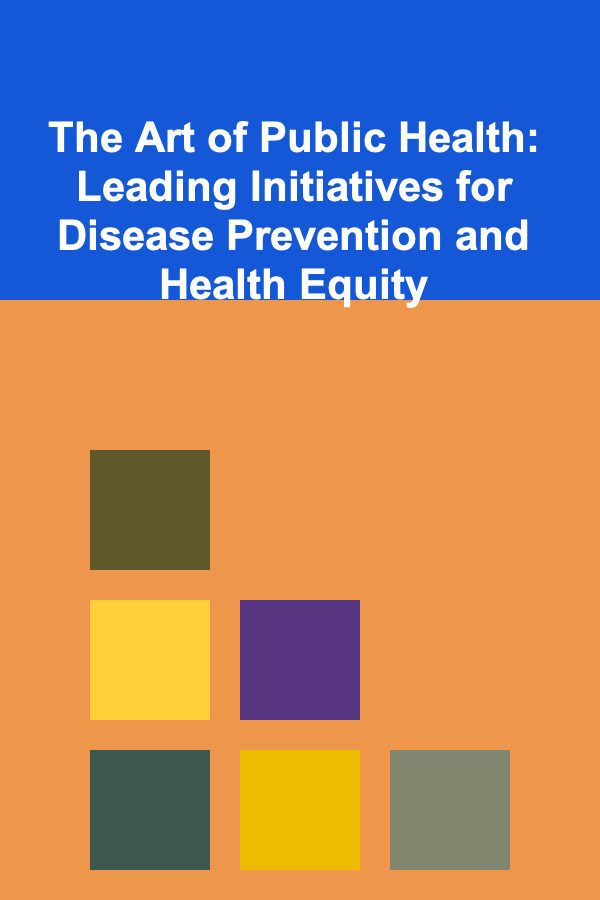
The Art of Public Health: Leading Initiatives for Disease Prevention and Health Equity
ebook include PDF & Audio bundle (Micro Guide)
$12.99$7.99
Limited Time Offer! Order within the next:

Public health is a dynamic and multidisciplinary field that requires the integration of scientific knowledge, community engagement, policy advocacy, and leadership to address the myriad health challenges that affect populations worldwide. At the heart of public health lies the ultimate goal of disease prevention and the promotion of health equity---ensuring that everyone, regardless of their background or circumstances, has the opportunity to lead a long, healthy life. In this article, we will explore the complex and nuanced aspects of public health, emphasizing the critical role of leadership in advancing disease prevention strategies and promoting health equity. This guide will provide actionable steps for leaders in public health to create impactful initiatives.
The Essence of Public Health Leadership
Public health leadership goes beyond merely managing resources or organizations---it's about creating a vision, aligning diverse stakeholders, and fostering systemic change. Leaders in this field must navigate the intersection of science, policy, and community dynamics. They must be innovative thinkers, advocates, and problem-solvers capable of driving long-term health improvements for entire populations.
Key Competencies of Public Health Leaders
Effective public health leaders share several core competencies:
- Visionary Thinking: Leaders must understand the bigger picture, anticipate emerging health issues, and propose forward-thinking solutions.
- Cultural Competence: Health leaders must engage with diverse communities, understanding cultural differences and tailoring interventions to fit the unique needs of each group.
- Evidence-Based Decision Making: Public health decisions should be rooted in data and research. Leaders must be adept at analyzing complex datasets and translating evidence into effective strategies.
- Collaboration and Partnership Building: Health equity cannot be achieved in isolation. Public health leaders need to collaborate across sectors---healthcare, education, housing, transportation, and social services---to build cohesive initiatives.
Disease Prevention: A Holistic Approach
Disease prevention is a cornerstone of public health. The focus is not only on treating illness but on reducing the risk of disease through proactive measures. Disease prevention strategies can be divided into three primary categories: primary , secondary , and tertiary prevention.
1. Primary Prevention: Preventing Diseases Before They Occur
Primary prevention aims to prevent the onset of disease by addressing risk factors before they lead to illness. This approach requires a multifaceted strategy that involves both individual and population-level interventions.
Actionable Strategies:
- Health Education and Awareness Campaigns: Raise awareness about healthy behaviors, such as proper nutrition, physical activity, smoking cessation, and mental health care. Public health leaders can use various platforms---social media, schools, community centers, and workplaces---to disseminate health messages.
- Vaccination Programs: Immunization is one of the most effective primary prevention strategies. Leaders should ensure that vaccination programs are accessible and equitable, particularly in underserved communities.
- Environmental Interventions: Improving environmental conditions, such as air and water quality, reducing exposure to harmful chemicals, and increasing green spaces in urban areas, can have significant public health benefits.
- Policy Advocacy: Public health leaders should advocate for policies that promote healthier environments, such as tobacco control laws, zoning laws that encourage physical activity (e.g., pedestrian-friendly cities), and restrictions on unhealthy food marketing.
2. Secondary Prevention: Early Detection and Intervention
Secondary prevention focuses on detecting diseases early, before symptoms appear, so they can be treated effectively and progression can be halted or slowed.
Actionable Strategies:
- Screening Programs: Encourage regular screenings for conditions such as cancer, diabetes, and hypertension. Leaders should work with healthcare providers to ensure that screening services are available, affordable, and accessible to all populations.
- Health Check-ups in Vulnerable Communities: Implement mobile clinics and outreach programs in underserved areas to provide early health assessments.
- Public Health Surveillance Systems: Invest in data collection and surveillance systems to monitor health trends and identify emerging threats. Early detection of infectious disease outbreaks, for instance, allows for quicker intervention and containment.
3. Tertiary Prevention: Managing Disease and Improving Quality of Life
Tertiary prevention focuses on helping individuals manage chronic diseases and improving their quality of life once a disease has been diagnosed.
Actionable Strategies:
- Chronic Disease Management Programs: Implement community-based programs that support people living with chronic conditions such as diabetes, hypertension, and heart disease. These programs should focus on self-management education, medication adherence, and lifestyle changes.
- Rehabilitation Services: Public health leaders should advocate for comprehensive rehabilitation services, such as physical therapy, mental health counseling, and vocational training for individuals recovering from severe illness or injuries.
- Patient and Caregiver Support: Provide resources and training for caregivers of individuals with chronic illnesses to ensure that families have the tools and knowledge to support their loved ones effectively.
Advancing Health Equity: A Critical Public Health Imperative
Health equity is an essential pillar of public health that seeks to eliminate disparities in health outcomes. It is grounded in the belief that everyone deserves the opportunity to achieve their highest level of health, regardless of their socioeconomic status, race, ethnicity, gender, or geographic location.
The Role of Social Determinants of Health
Social determinants of health (SDH)---such as income, education, employment, social support, and access to healthcare---play a significant role in shaping health outcomes. Public health leaders must address these determinants to reduce health disparities and promote health equity.
Actionable Strategies:
- Addressing Poverty and Economic Inequality: Poverty is a major driver of poor health outcomes. Public health leaders can advocate for policies that increase access to affordable housing, nutritious food, and employment opportunities, all of which contribute to better health outcomes.
- Improving Access to Healthcare: Leaders should work to expand healthcare access, especially in rural and underserved urban areas, through community health centers, mobile clinics, and telemedicine.
- Educational Initiatives: Educating people about the importance of health and providing access to information can reduce health disparities. Public health initiatives should focus on reaching underserved populations with culturally appropriate education that promotes healthy lifestyle choices.
- Combatting Structural Racism: Public health leaders must address the impact of systemic racism, which can contribute to poor health outcomes among marginalized communities. This may involve advocating for policies that reduce discrimination in healthcare settings, improving representation of minority groups in health research, and addressing the disproportionate impact of environmental hazards on certain communities.
Building Inclusive Policies and Practices
Equity-focused policies and practices are key to addressing the root causes of health disparities. Public health leaders must ensure that interventions are designed with the diverse needs of all communities in mind.
Actionable Strategies:
- Community Empowerment: Public health leaders should empower communities to take ownership of their health by involving them in the decision-making process, co-designing health initiatives, and providing support for grassroots movements.
- Culturally Tailored Interventions: Implement programs and services that are sensitive to the cultural, linguistic, and social needs of diverse communities. This includes training healthcare workers in cultural competency and ensuring that public health messages resonate with all populations.
- Data-Driven Policy Advocacy: Use disaggregated health data to identify health disparities and advocate for policies that target the specific needs of vulnerable populations. This approach ensures that resources are allocated where they are needed most.
Conclusion: Shaping a Healthier Future
Leading public health initiatives for disease prevention and health equity requires a multifaceted approach that integrates evidence-based strategies, cross-sector collaboration, and a deep commitment to social justice. Public health leaders must work relentlessly to tackle the social determinants of health, advocate for systemic change, and implement innovative programs that reduce health disparities.
In this ongoing effort, public health leadership is not just about managing health systems; it's about transforming the environments and policies that shape people's lives. By fostering collaboration, leveraging data, and prioritizing equity, public health leaders can help ensure that all individuals, regardless of their background, have the opportunity to live healthier, longer lives.
As we move forward, the art of public health will continue to evolve, but the core mission remains: to protect, improve, and promote the health of all populations. Public health leaders, armed with a deep understanding of the challenges and opportunities at hand, will remain at the forefront of this crucial work.
Reading More From Our Other Websites
- [Home Holiday Decoration 101] How to Bring the Outdoors Inside with Holiday Decorations
- [Personal Investment 101] How to Avoid Common Investment Mistakes and Protect Your Assets
- [Home Rental Property 101] How to Prepare Your Rental Property for Winter
- [Star Gazing Tip 101] From Constellations to Canvas: Artistic Inspiration Under the Stars
- [Home Family Activity 101] How to Make Family Road Trips More Enjoyable with Fun Games
- [Personal Finance Management 101] How to Plan for Holiday Spending Without Going Into Debt
- [Organization Tip 101] Why Having a Home Inventory is Essential
- [Biking 101] The Pros and Cons of Different Bike Locks: A Comprehensive Comparison
- [Personal Financial Planning 101] How to Pay Off Credit Card Debt: Strategies for Becoming Debt-Free
- [Home Storage Solution 101] How to Store Your Sports Equipment in an Organized and Accessible Way

How to Develop an Inventory Plan for Expensive Items
Read More
How to Store Unfinished Projects Neatly
Read More
How to Grasp the Concepts of Airdrops and Bounties
Read More
Mastering a Strong Online Presence for Print-on-Demand (POD)
Read More
How to Create a Daily To-Do List for Creative Professionals
Read More
10 Tips for Fitness Trainers to Optimize Client Nutrition Plans
Read MoreOther Products

How to Develop an Inventory Plan for Expensive Items
Read More
How to Store Unfinished Projects Neatly
Read More
How to Grasp the Concepts of Airdrops and Bounties
Read More
Mastering a Strong Online Presence for Print-on-Demand (POD)
Read More
How to Create a Daily To-Do List for Creative Professionals
Read More